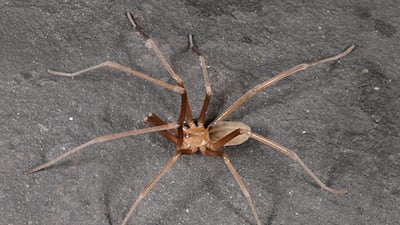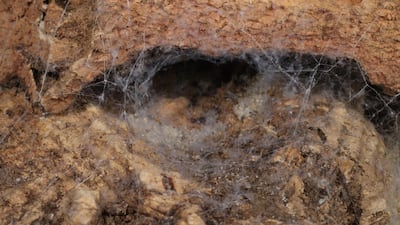Male members of a cannibal species of spider found in the UAE have been studied for the first time by experts.
When it comes to the Sahastata nigra, the female of the species is certainly deadlier than the male. They are much larger and live far longer, too.
The young of Sahastata nigra, to use the arachnid's scientific name, are liable to eat one another. Males, who make up just a quarter of the species' population, risk being cannibalised if they approach a female in the hope of mating with her.
Although these life habits may sound off the wall, they are actually not unusual for the spider world, according to the researcher who recently discovered that the species is present in the UAE.
“Spiders are not very social,” said Dr Ivan Magalhaes, of the Argentinian Museum of Natural Sciences. “With few exceptions, most spiders are solitary and they’re not very tolerant of members of their own species.
“Because they’re generalists regarding their diet, they will eat anything they can capture. So when the male approaches the female, she can accept him as a mate, but if she’s not receptive or doesn’t like him for whatever reason, he can be seen as food.”
The killing and eating of the male by the female echoes the notorious black widow spider, although with Sahastata nigra, cannibalism takes place before rather than after mating.
Dr Magalhaes and other scientists in Germany, Israel, Russia and South Africa recently published a paper in the journal, Zootaxa, in which they reveal for the first time that Sahastata nigra is found in the UAE.
Key discovery made in Fujairah

Specimens were collected from Fujairah and north of Khor Fakkan several years ago and kept in a museum collection in Germany, but were analysed only recently.
Dr Magalhaes performed a detailed examination of the morphology, or form, of the specimens – the genitalia are typically used to distinguish between species – and recognised they belonged to Sahastata nigra.
First described by scientists at the end of the 19th century, the spider was thought to have been present all the way from Morocco to western India.
However, the latest study found that some populations actually belong to new species, and the only countries where the spider is now known to be present are Oman and the UAE.
An arachnid unlikely to make house calls
The species inhabits sparse habitats with few people and although it uses venom to disable prey, is not harmful to people.
Unsurprisingly given its habitat, Sahastata nigra tolerates severe conditions. Individuals in captivity cope with temperatures above 40°C for several months. They can survive with very little water and go for months without food. In the wild, they catch insects and other small arthropods in a web of fine silk.
Male of the species analysed for first time
Previously, no males had ever been found, but one of the paper's authors, Mark Stockmann, collected females with egg sacks in Oman and hatched out the young.
In captivity, up to 200 young were produced, although these underwent what the researchers described as “massive cannibalism”.
Just 20 to 25 percent of juveniles were male, although it is not known why. It is possible, Dr Magalhaes said, that the spiders were infected with a bacterium passed down only through the female line that selectively caused male eggs to fail to hatch. Further investigation would be needed to confirm this.
Males are smaller and much lighter in colour than the black females, which have bodies up to 15mm long. Such sexual dimorphism, as it is known, is found in many spiders.
As well as being rarer and smaller, males do not live as long, surviving for as little as two to three months once they reach maturity, just a fraction of the length of time of females.
A spider facing an uncertain future
The finding that Sahastata nigra has a much more limited range than had been thought means the species is more at risk should numbers fall. Threats to spiders include habitat loss and aridification, in which an area becomes increasingly dry.
Although there are more than 49,000 spider species worldwide, and new ones are described regularly, Dr Magalhaes said the loss of any one species could prove significant because each plays a part in the ecosystem.
“Every species has its role in the environment even though it may not be immediately clear to us,” he said.
“They support a network of interactions. If you remove a particular species, this network will be disturbed. They are important for ecological equilibrium.”
He said spiders were also valuable because they consumed insects that could otherwise become pests, with estimates suggesting they eat 400 million to 800 million tonnes worldwide each year.
Simply identifying and describing spider species is regarded as critical, because otherwise some could become extinct without science knowing.
“It’s very urgent. We need to describe this biodiversity before it disappears,” said Dr Magalhaes.




















